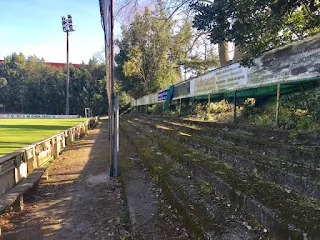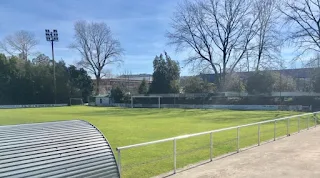Club
Deportivo Getxo is a football club from the town of Getxo who were formed in
1927 and is located along the north bank of the port and marina area in the
greater Bilbao area in Spain’s Basque Country.
At the time of their formation in the Algorta neighbourhood of the town, Arenas Club de Getxo were enjoying a golden period, which would reach its pinnacle when they lifted the Copa del Rey in 1929.
From 1929 to 1945, the club competed in regional football before progressing to the Tercera División in 1945-46, where they met Arenas for the first time in competitive football. The club were relegated back to regional football at the end of the 1948-49 campaign.
However, the team won back their status just twelve months later. Future Athletic Club stars, defenders José Orúe and Manuel Etura, along with midfielder Koldo Aguirre, cut their teeth at Getxo, as the club lifted the Grupo III title of the Tercera División in 1958-59 and remained at the third-tier level until 1965-66.
Despite the setback of relegation, the team fought back at the first time of asking to return to the Tercera División. In 1969-70, Getxo finished in the relegation positions once again, dropping back down to regional football as future Spain and Athletic Club star striker Dani progressed through the youth ranks.
Getxo took two seasons before regaining their third-tier status in 1971-72. Their return was marked with a fourth-place finish in Grupo I. After a few seasons of mid-table finishes as the Tercera División became the fourth tier, the team progressed to win promotion to Segunda División B, which was the third level of Spanish football.
A bottom-placed finish of Grupo I meant that Getxo returned to the Tercera División. In 1984-85 the club went down another step, but not for the first time they battled back. This time their spell in regional football would last a few seasons before they were crowned champions of the División de Honor de Vizcaya in 1989-90.
In 1997-98, Getxo finished bottom of the Grupo IV table in the Tercera División. The club were relegated further down to the sixth-tier Territorial Preferente owing to misdemeanours, but fought back to the División de Honor in 1999-00.
Eventually, Getxo finished in a promotion place in 2004-05 to return to the Tercera División. It proved to be a step too far as the team finished in a relegation spot and had to return to fifth-tier football. The 2011-12 campaign saw the club regain its Tercera División place as Getxo won the División de Honor championship.
This was under the managership of former Athletic Club star Endika Guarrotxena. Once again, fourth-tier football would only be played at Campo Municipal de Fadura for one season. A runners-up place in the 2013-14 División de Honor was enough to secure promotion for ‘Guaitos’.
The club finished in mid-table in Grupo IV in 2016-17 thanks to the goals of Lander Guarrotxena under managers Ramón Castelo and Rubén Carreňo. Omar Alonso Lekue was given the manager's job for the 2018-19 campaign after the team had been relegated to División de Honor Vizcaya.
A third place was achieved in 2019-20 under manager Xabi Herrero before Iker Casado was given the job, with Herrero later returning to the role. The side went on to finish in eighth and sixth positions before a disappointing 2022-23 campaign, by which time the division was the sixth tier of Spanish football.
The team went on to finish runners-up in the league in 2024-25 under manager Aitor Uria. A win against Ariznabarra saw the side within grasp of promotion, but they were denied on penalties against Zarautz, after the club had provided free buses for supporters to travel to Asti.
CD Getxo
will play in the División de Honor Vizcaya in the 2025-26 season.
My visit
Monday 27th February 2017
It was a
stunning lunchtime as I alighted from the train at Aiboa station on the final
full day of a simply brilliant long weekend visit to Bilbao and its surrounding
areas. Getxo was to be the final football venue I would call in at on the trip.
I walked
down the slope from the station and mistakenly thought I’d found the venue a
lot easier than I initially anticipated on Los Chopos Etorbidea. It transpired
that the artificially surfaced arena with a small, neat stand was used by the
junior sides at the club.
A short walk
further up the road, past a gym, brought me to the entrance of Campo Municipal de
Fadura across the road from Salsidualde Estarta. It looked like a cracking old school
venue, and the gate was open!
A groundsman
was carrying out his tasks. A smile, a wave and “ola” meant I was fine to take
some photos inside. My instinct was correct. It was a cracking ground with its
old-fashioned raised stands down one side separated by a pavilion containing
the dressing rooms, which wouldn’t have looked out of place in an English
cricket ground.
Both ends
and the far side had open terracing. It was obviously a venue surrounded by
history and had staged some memorable matches over the years.
Once done, I
headed back to Aiboa station, from where I caught the train to Gobela, near the home of neighbours Arenas, before cutting down to the waterfront from where
I walked along the bay to the mouth of the Nervión.
My walk
continued before taking a ride on the Bizkaiko Zubia Transporter Bridge to the
south bank for the train from Portugalate to San Mamés, before taking a tram all
the way through the city into the old town to Atxuri to continue exploring a
truly magnificent city.











No comments:
Post a Comment